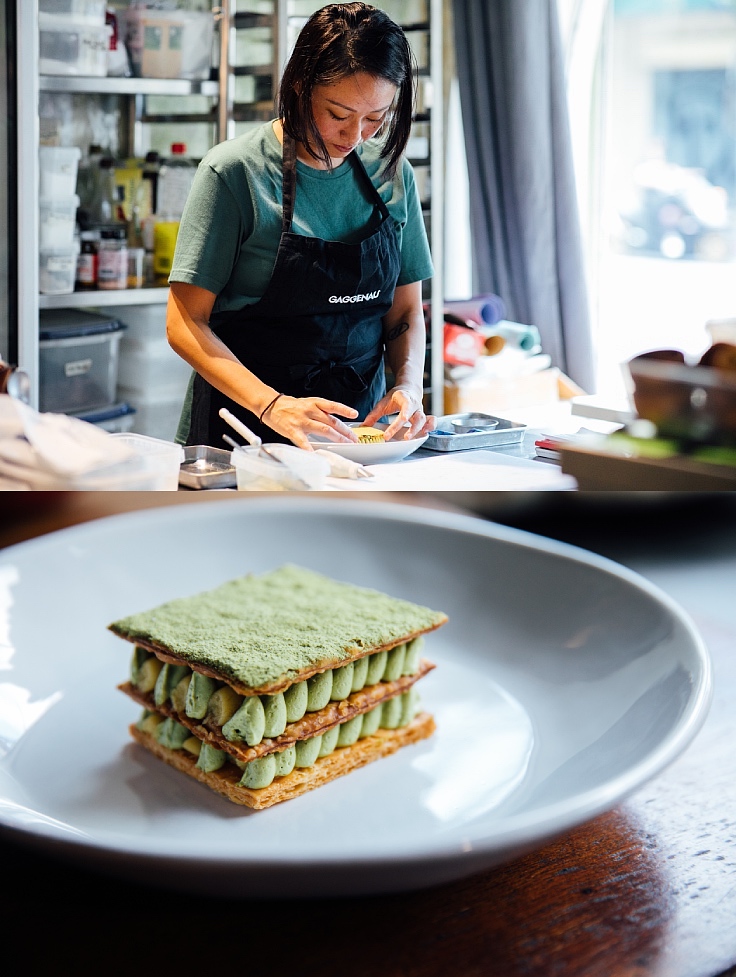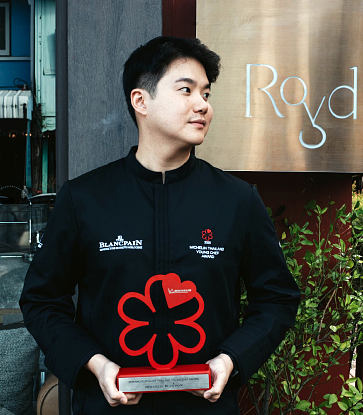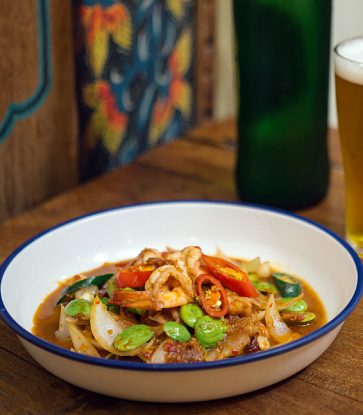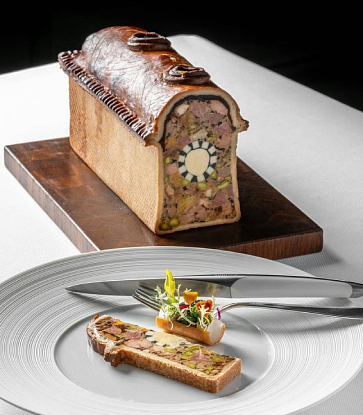If you think a chef cooks great food, imagine the influence and support behind that toque and apron. Countless chefs speak of their mothers as their inspiration, the wind beneath their wings — and this certainly applies to the chef couple behind Samlor, newly listed in MICHELIN Guide Thailand 2022.
Studying at a renowned culinary institution rarely looms large in a chef’s success story. Many have shared with us similar “origin” stories, that their passion for food started with family—after watching the labours and tasting the flavours of love in their mother’s cooking. These sentiments were echoed by the talented chefs, and recent parents themselves, Napol “Joe” Jantraget and Saki Hoshino, who were the forces behind scoring 80/20 its first MICHELIN Star a few years back.
They have since moved on to new challenges with their new restaurant Samlor. As many expected from this creative couple, it has already made it into the 2022 edition of MICHELIN Guide Thailand. But you’ll have to hang on until the end of the year to find out which award they’ve won. Both chefs attested to their mothers as great influences on their successful careers. On this occasion of Mother’s Day in Thailand, Jantraget and Hochino share their fond memories of maternal love and warmth, and of the dishes that remind them of their mothers.

Mom’s cooking: a symbol of love and memories
“My journey to becoming a chef may not have started out typically like other chefs, who usually liked to cook since they were young. I tried to find myself elsewhere but ended up with food anyway. I have to admit that my mother had a really large influence on that.”Chef Jantraget recalled that his relationship with his mother in the kitchen did date back to his childhood. As an only child, he was often called to help her out. He confessed that at that time, he didn’t really like being his mother’s assistant in the kitchen, because he preferred to be out and about.
“I had a wild child phase, so my mother sent me to school in Canada to shape up. At that time, she lived in America, so she could come visit me often. During that time, it was extremely difficult to find authentic and delicious Thai food in Canada. I would get such homesick cravings for Thai food,” he continued. “Whenever my mother came to visit, she’d bring me all sorts of ingredients and seasonings to cook with. If we were to cook something and thought about eating it the next day, my mother would be making preparations the day before. That’s my mother alright! She is a very meticulous person.”
The once-a-wild-child chef also shared, “I wasn’t even studying to be a chef at that point. I was studying restaurant and hotel management. When Mom came to visit and cooked for me, I had to be her assistant for everything— down to washing the coriander roots. That’s now a standard at our restaurant: when we wash the roots, we must grate it clean until it is white and absolutely no dirt is left. Then, we store it carefully for use later. When my mother used to prepare ingredients, she would be very scrupulous like that. It’s something that’s stuck with me, and now I want my restaurant to do so as well.”
He saw his mother cook so often that he became absorbed and started to want to cook for himself. “I’d invite friends over, and we’d make Thai food to eat together. I credit all my interest in cooking to my mother, and I eventually decided to further my studies in food. My mother is not only my motivator, but also someone who gave me support and advice. Everything that has happened till now is because of my mother.”
Chef Jantraget’s mother has roots in Southern Thailand and hails from the province of Nakhon Si Thammarat, renowned for its fiery curries. Most southerners usually make their own curry paste, which is also the case with his mother. Dishes she would often cook for the chef include pumpkin curry and fish curry, with taste profiles that aren’t too spicy but offer a pleasant well-roundedness. The chef fondly remembers that whenever his mother came to visit, she’d cook up a large pot of curry. Then, she’d portion it out to be kept in the freezer— an act of love and concern that her son wouldn’t have anything to eat. Nevertheless, when asked what dish reminds him of his mother, his surprising answer is the deceptively simple “khai jiaw” (Thai omelette).

Mother’s khai jiaw, the dish of love
Ask any Thai what is the comfort food that reminds them of home, and the answer will usually be khai jiaw. “The thing about this staple dish is every Thai mom surely has their own recipe for their khai jiaw, so it tastes different everywhere. My mother liked to make hers with spring onions. This made her khai jiaw on the sweeter side.”He continued, “Whenever I eat a Thai omelette, another dish that comes to mind and goes really well is roasted curry. You’re all set with just these two dishes. They compliment each other, and it’s an easy but very delicious meal. It also makes me think of the taste of my mother’s cooking. Whenever my mother makes crab curry with betel leaves, she makes her own curry paste— the way Thai Southerners do. She’ll put huge chunks of crab meat in, because she doesn’t like to use the whole crab, where you have to get your hands dirty when taking it apart to eat. This is the other dish that makes me think of my mom.
“When I’m cooking, I always ask myself, ‘how would mom cook this?’,” shared the Thai chef.
“I think it’s difficult to define what’s delicious when it comes to a mother’s cooking, because every mom creates delicious food in their own way. It also depends on what you’re used to eating and how you grew up. If you like to eat things made a certain way, it’s likely that you would want others to eat something like that too.”
Never one to shy away from being a mummy’s boy, the chef shared, “Even today, I still ring my mother up to ask for her recipe for my cooking.” He continued, “People from her generation don’t really do measurements though and will tell you to season and taste along as you cook. What’s just as important is I make sure to add my own creativity [to the dish] as well.”

“People who like to cook tend to seek knowledge from around themselves. However, I feel that they may already be surrounded by good food but tend to overlook it because it’s so close to home. That would be your mother’s cooking. Even now, I still regret not paying more attention to the things my mother did while cooking when I was younger. These days, my mother doesn’t have the strength to work in the kitchen like she used to. This knowledge isn’t limited to mothers only. Other family elders, like grandmothers, are also sources of vast knowledge. There’ll come a day when they won’t be able to cook anymore, so if possible, I think it’s important to study, preserve, and pass down those recipes and flavours. After all, food is another representation of love and memories."

Food and mille-feuille: What binds a family and spreads happiness
“When I was a girl, my mother liked to bake all sorts of sweets, be it cakes, cookies, or others. She still loves to bake. I remember that as a child, my mother would get me to help knead the flour or shape the dough. Being a kid, I’d secretly taste what we made, and she’d have to tell me off because we weren’t finished yet. I must have absorbed all that from my mother.”Chef Hochino also considers her mother as her main inspiration and influence instilling in her a love for cooking, eventually leading her to become a chef. Her mother is not a professional pastry chef, nor did she attend any culinary school. She educated herself by way of cookbooks and cooking shows to the point that the sweets she baked were deliciously second to none.

After her studies in hospitality management, Hochino decided to further her education at a culinary school in Canada. At first, the Japanese chef wasn’t too sure what her mother’s reaction would be to her deciding to study pastry-making and wanting to become a chef. Unexpectedly, her mother was very happy with the decision— possibly from her understanding of the happiness that comes with baking. Perhaps it also brought her great joy to be a source of inspiration for Hochino.
When asked what confection makes her think of her mother, the Japanese pastry chef easily responded with the French pastry “mille-feuille”.
“My mother liked to make mille-feuilles during the autumn. She’d use sweet potatoes for the filling. The mille-feuilles she made were very simple, where she’d use both matcha and whipping cream. It wasn’t particularly perfect, but it was delicious in her way. It’s a dish that makes me think of her, so I put a mille-feuille in the lunch dessert menu at Samlor. We make ours like hers – with sweet potatoes and matcha cream.”

From daughter to mother
Now a new mother herself, Hochino learns from her one-year-old-and-a-half daughter, Mia.“Mia taught me to be more understanding of what mothers go through, because she is a very picky eater. It made me realise that cooking for infants can be difficult, because you need to take so many factors into account. Will they like the taste? Will they be able to eat it? Will they be getting all the necessary nutrients? How can I successfully trick my child into eating healthy things they sometimes don’t want to eat? I had to learn all these things from scratch, and I have to think a lot more. It’s made me even more understanding and grateful for all the things my mother has done for me—her efforts, hardships, love, and devotion.”Seeing Mia as a child growing up in a restaurant, Hochino looks forward to when she is old enough to spend time baking and cooking in the kitchen with her – the way she did with her mother when she was young.
Hero image and other images:© Akkapat Inthuprapa / MICHELIN Guide Thailand




















